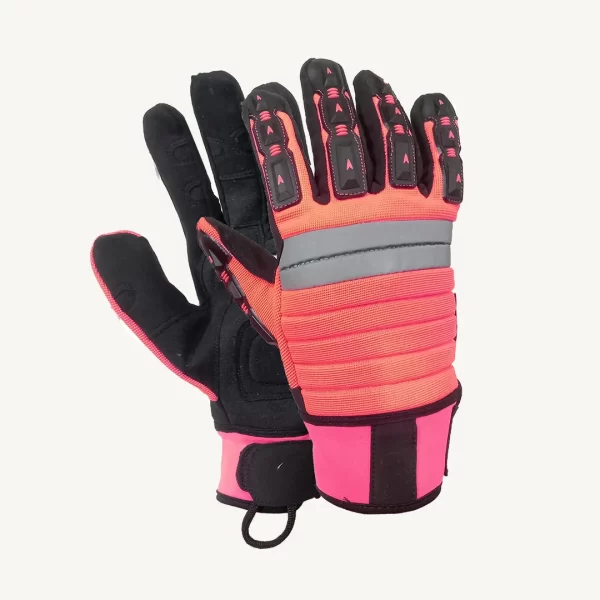As someone who has worked in construction for over 15 years, I know first-hand the importance of protecting your hands from impact hazards. After enduring several hand injuries early in my career from falling debris and pinched fingers, I vowed to always wear high-quality impact resistant gloves tailored to my work. Proper hand protection has allowed me to work safely while maintaining excellent manual dexterity.
Based on my personal experiences and extensive research, I’ve created this comprehensive guide on choosing the right pair of impact resistant gloves for your unique risks and needs. Keep reading to ensure you safeguard yourself from long-term hand injuries.
Understanding Impact Hazards in the Workplace
Impact hazards encompass a wide range of risks that can crush, bruise, or fracture hands. Several common examples include:
- Falling objects – e.g. bricks, tools, materials
- Pinched fingers from machinery and equipment
- Sharp blows from hammers, chisels, and other hand tools
- Collisions with heavy objects
Nearly any workplace has potential impact risks. Those with frequent manual handling in hazardous environments tend to have greater needs for hand protection.
Highest Risk Occupations and Activities
The most hazardous occupations like construction, manufacturing, maintenance, and mining require heavy-duty impact resistant gloves. Workers in these trades frequently deal with:
- Heavy machinery operation – cranes, forklifts, compactors
- Masonry and brickwork
- Demolition and wrecking
- Metal fabrication – welding, grinding, hammering
- Working at heights where objects may fall
Top-grade protection is crucial but dexterity and flexibility remain vital. opt for rugged gloves with molded plastic guards, thermoplastic rubber (TPR), and extra padding on the fingers and knuckles.
Moderate Risk Occupations and Activities
Landscaping, forestry, warehousing, mechanics, and transportation fall under the ‘moderate risk’ category. While handling lighter materials, workers still encounter:
- Power tool operation – trimmers, chainsaws, nail guns
- Moving equipment and goods
- Tree branch hazards
- Slippery conditions causing falls
Prioritize gloves with reinforced palms and fingertips. Breathable fabrics like spandex and lycra provide flexibility, patches of synthetic leather or rubber enhance grip and abrasion resistance.
Low Risk Recreational Activities
Everyday DIYers, hobbyists, and gardening enthusiasts still require basic hand protection during minor home/property improvement projects. These individuals face risks like:
- Minor cuts, punctures, scrapes
- Hand tool impact – hammers, shovels, picks
- Wood splinters
- Minor falls on gravel or pavement
Value ergonomic padded gloves made of fabric, cotton, or synthetic materials. Pick touchscreen compatible pairs allowing device use without removal. Consider handy features like foam knuckle protection and spandex Lycra finger gussets for optimal movement.
Matching Glove Features to Your Impact Risks

Now that we’ve categorized common impact hazards, let’s examine the ideal glove characteristics for each risk level:
High Risk Protection Features
- Thermoplastic or molded rubber guards
- Reinforced leather or synthetic leather palm and fingertips
- Padding or foam over knuckles and fingers
- Durable fabrics resisting tears, abrasions and punctures
- Wrist support through adjustable straps or elastic cuffs
Medium Risk Protection Features
- Lightweight leather, synthetic leather or textile palms
- Padded foam or TPR finger guards
- Elastic finger gussets for flexibility
- Durable grip patches in high abrasion areas
- Terry cloth thumbs allowing sweat wiping
Low Risk Protection Features
- Breathable stretch fabrics for excellent dexterity
- Padded foam knuckles
- Synthetic leather or rubber palm and fingertip patches
- Terry cloth forehead wipe
- Touchscreen conductive thumb and fingertips
Vital Factors When Selecting Your Impact Gloves
Beyond matching glove performance to your hazards, also consider:
Fit and Comfort
A proper fit enhances protection and reduces hand fatigue. Ensure optimal flexibility through the fingers and a snug fit around the palm and wrist.
Maintenance
Check gloves regularly for cracks, holes or excessive wear compromising protection. Follow manufacturer cleaning recommendations.
High Quality Materials
See the gloves are certified to relevant safety standards for impact protection. Opt for reputable manufacturing brands specializing in occupational hand safety.
Conclusion
Protecting yourself from all potential impact glove hazards involves selecting the right combination of protection, dexterity, grip, and comfort. Renew your impact resistant gloves regularly and have them suit your exact environment. Safe hands permit a productive career free of lost time incidents!





